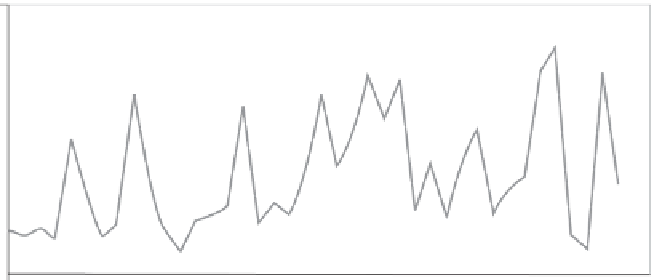Agriculture Reference
In-Depth Information
120
10 0
80
60
40
20
0
1964
1969
1974
1979
1984
1989
1994
1999
2004
Ye a r
Fig. 6.6
Total surface area of fires in Chile by annual fire season. Each season stretches from
October to April of the following year. The value indicated for the season corresponds to the
year the season ended. (Data from Soto
1995
;
CONAF
2003
.
)
only about 1% extending over large areas and causing significant economic
damage (Soto
1995
; CONAF
2003
). Data collected since the 1960s indicate
that the average size of fires has dropped from
50 ha in the 1960s and 1970s
to
<
10 ha in the 1990s (Table 6.2). There are few large fires: 87% of the fires
are less than 5 ha and more than 90% are under 10 ha. However, large fires
up to 50 000 ha have occurred.
It is clear that the historical fire frequency in the Valdivian forests of Los
Lagos Regio´ n (Regio´ n X) was dramatically increased after 1880 with the settle-
ment of the area by European colonists. Fire was widely used in this period to
clear land for agriculture and grazing, and tree ring records clearly show this
increase in fires (Gonza´ lez
et al.
2005
), with an estimated 400 000 ha of forest
burned in 1853 alone (Cavelier & Tecklin
2005
). More than 11 million ha of forest
were burned overall with the expansion of agriculture and ranching in this region
(Haltenhoff
1991
). Detailed fire records have been kept by the Corporacio
´
n
Nacional Forestal (CONAF) since 1979. Virtually all fires from Los Lagos
Regio´ n over this period were attributed to accidental or intentional human
actions, although both lightning and vulcanism have been documented as natural
sources of fire for the region (Lara
et al.
1999
; Veblen
et al.
1999
). Annual climate
cycles and seasonality show a strong relationship to the size of fires. Three of these
dry summer regimes with large fires were associated with strong ENSO (see Box
1.2) conditions: 1983, 1987 and 1997. However, other years with dry summers
have not had large fires, suggesting the timing of human ignitions are a factor.
Half of the fires in Chile occur within the MTC area of central Chile, from north
of Valparaı´ so to near Concepcio´ n (Regiones V, VI and VII). Fires are more
limited northward because the open shrublands and semi-desert scrub lack the
continuity of fuels to carry fire. In the south a large increase in numbers of major
>



















